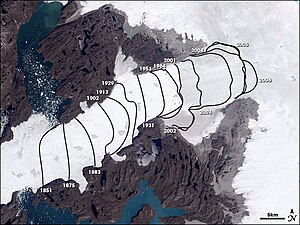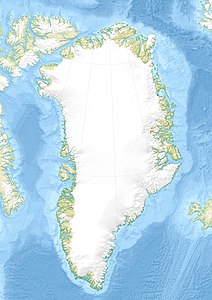Jakobshavn Isbræ
| Jakobshavn Isbræ | ||
|---|---|---|
|
Aerial view of Jakobshavn Isbræ. The lines mark the progressive retreat of the calving front of the west Greenland glacier from 1851 to 2006. |
||
| location | West coast of Greenland | |
| Type | Outlet glacier , tidal glacier | |
| length | 80 km | |
| surface | The catchment area comprises 6.5% of the Greenland ice sheet, which corresponds to 110,000 km² | |
| Exposure | west | |
| Altitude range | 1400 m - 0 m | |
| Coordinates | 69 ° 10 ′ N , 49 ° 50 ′ W | |
|
|
||
The Jakobshavn Isbræ ( Greenl . : Sermeq Kujalleq , "Southern Glacier") is an outlet glacier located near the Greenlandic Ilulissat ( Danish Jakobshavn ) . The glacier represents a considerable part of the Greenland ice mass. Its catchment area comprises about 6.5% of the inland ice. Its ice flows into the Ilulissat Icefjord on the west coast of Greenland. The mass of icebergs that detach from its glacier tongue every year adds up to 35 billion tons; the glacier therefore calves most frequently in the entire northern hemisphere. Individual icebergs can be several kilometers long and up to one kilometer high.
Glacial melt
The Jakobshavn Isbræ has been in retreat since at least 1850 . In the course of the global melting of glaciers as a result of global warming in the Arctic , this ice flow released so much ice into the sea between 2000 and 2010 that it alone caused the sea level to rise by one millimeter.
dynamics
With flow speeds of 7000 meters per year, the glacier is (as of 2008) the fastest flowing ice stream in the world. Only so-called surge glaciers can flow much faster for a limited period of time. After a period of relative stability lasting several decades, the flow rate of the glacier has increased dramatically since the late 1990s, while the glacier's floating tongue has lost its thickness and has crumbled. Since the glacier lost its floating tongue, it has been showing clear seasonal fluctuations: in winter the glacier flows more slowly, the calving front advances ; in summer the glacier becomes faster and the front retreats. The flow velocity at the end of the glacier, which has risen continuously in recent years, is also increasingly influencing the higher-lying areas of the glacier, whereby it is also becoming less thick. In the summer of 2012, the highest flow speed to date was measured one kilometer above the end of the glacier, it was 46.8 m per day and is considered the highest speed ever measured by an outlet glacier in Greenland or the Antarctic . The average flow velocity over 2012 was three times as high as in the mid-1990s.
In July 2018, an article by two researchers at the University of Kansas appeared in the journal Science . According to this, the ice is moving into the sea faster than simulations predict in 140 locations examined. The usual sliding equation, as it is used in many models for ice sheet forecasting, has calculated the friction on the underside of the ice too low so far.
Jakobshavn Isbræ is one of several Greenland sea glaciers where glacial tremors have been registered.
Trivia
The iceberg with which the Titanic collided in 1912 probably came from Jakobshavn Isbræ. The glacier is also a tourist destination ; in 2008 about 20,000 people visited it.
Web links
- NASA Earth Observatory: Fastest Glacier in Greenland Doubles Speed January 12, 2004
Individual evidence
- ↑ a b c d Geological Survey of Denmark and Greenland (GEUS): Portrait of the ice at Ilulissat ( Memento of the original from August 29, 2012 in the Internet Archive ) Info: The archive link was automatically inserted and not yet checked. Please check the original and archive link according to the instructions and then remove this notice.
- ^ A b I. Joughin, BE Smith, DE Shean, D. Floricioiu: Further summer speedup of Jakobshavn Isbræ (PDF; 1.7 MB). In: The Cryosphere 8, 2014, pp. 209–214, doi : 10.5194 / tc-8-209-2014 (English)
- ↑ Joachim Müller-Jung: Glacier melt at record speed. The Titanic ice sheet does 46 meters a day . In: FAZ Wissen February 2, 2014.
- ^ Joseph Holden: An Introduction to Physical Geography and the Environment. Prentice Hall, Harlow 2008, ISBN 0131753045 , page 522
- ^ Friction at the bed does not control fast glacier flow
- ↑ Die Zeit 31/2018: Faster than allowed
- ^ Göran Ekström, Meredith Nettles & Victor C. Tsai: Seasonality and Increasing Frequency of Greenland Glacial Earthquakes. In: Science Vol. 311 (March 24, 2006), pp. 1756–1758 PDF , accessed on March 31, 2018 (English).
- ↑ Süddeutsche Zeitung No. 292, December 18, 2009, page 16, Knowledge, Ten Things You Didn't Know About Glaciers (photos online )

